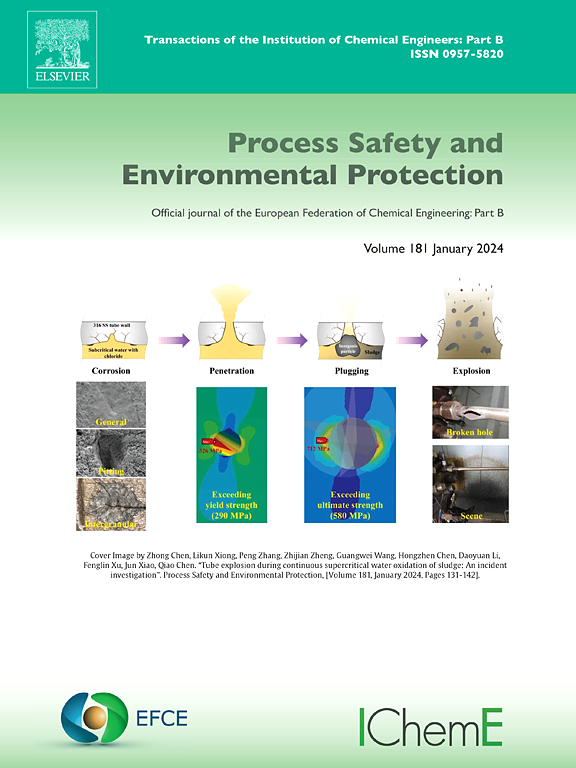IF 6.9
2区 环境科学与生态学
Q1 ENGINEERING, CHEMICAL
引用次数: 0
摘要
寒冷、干燥地区的 PM2.5 污染通过作为化学和微生物载体的双重作用,显示出更强的累积效应。本研究调查了哈尔滨的 PM2.5 和相关微生物气溶胶(2023 年 10 月至 2024 年 3 月),以跟踪时间趋势并确定生物成分驱动因素。PM2.5 浓度范围为 0.020-0.101 毫克/立方米,平均浓度为:重金属(699.42 纳克/立方米)、二次离子(16.51 微克/立方米)、多环芳烃(20.99 纳克/立方米)和可培养微生物(129.57 CFU/立方米)。多环芳烃健康风险评估显示癌症风险较低。利用富集因子分析、扫描电子显微镜 (SEM) 和主成分分析-多重线性回归 (PCA-MLR),我们确定燃煤和汽车尾气排放是主要来源。微生物气溶胶在 1.1-2.1 μm 的颗粒(21.04 %-51.31 %)中达到峰值,表明在粗颗粒上的活性更大。基因组测序显示 Achromobacter(44.68 %)是主要的细菌属,Epicoccum(33.13 %)是主要的真菌属。功能分析表明,细菌在新陈代谢过程中占主导地位,而真菌则专门从事营养生长。斯皮尔曼相关分析进一步证明了化学物质与微生物之间的相互作用:锑、硒、镍、铝、砷、铬、多环芳烃和无机离子等元素,以及大气压力和风速等气象因素,与微生物的浓度、活动水平和群落组成呈不同程度的正相关或负相关。本文章由计算机程序翻译,如有差异,请以英文原文为准。
PM2.5 and microbial aerosols in cold climates: Biological and chemical characteristics, correlation, and source identification during the heating period
PM2.5 pollution in cold, dry regions demonstrates heightened cumulative effects through dual roles as chemical and microbial carriers. This study investigated PM2.5 and associated microbial aerosols in Harbin (October 2023–March 2024) to track temporal trends and identify biological component drivers. PM2.5 concentrations ranged from 0.020–0.101 mg/m3, with mean concentrations of: heavy metals (699.42 ng/m3), secondary ions (16.51 μg/m3), PAHs (20.99 ng/m3), and culturable microbes (129.57 CFU/m3). PAH health risk assessments indicate a low risk of cancer. Using enrichment factor analysis, scanning electron microscopy (SEM), and principal component analysis-multiple linear regression (PCA-MLR), we identified coal combustion and vehicle emissions as dominant sources. Microbial aerosols peaked within 1.1–2.1 μm particles (21.04 %–51.31 %), demonstrating greater activity on coarse particles. Genomic sequencing revealed Achromobacter (44.68 %) as the predominant bacterial genus and Epicoccum (33.13 %) as the dominant fungal genus. Functional profiling indicated bacterial dominance in metabolic processes and fungal specialization in saprotrophy. Spearman correlation analysis further demonstrated distinct chemical-microbial interactions: elements like Sb, Se, Ni, Al, As, Cr, PAHs, and inorganic ions, along with meteorological factors such as atmospheric pressure and wind speed, exhibited varying positive or negative correlations with microbial concentrations, activity levels, and community composition.
求助全文
通过发布文献求助,成功后即可免费获取论文全文。
去求助
来源期刊

Process Safety and Environmental Protection
环境科学-工程:化工
CiteScore
11.40
自引率
15.40%
发文量
929
审稿时长
8.0 months
期刊介绍:
The Process Safety and Environmental Protection (PSEP) journal is a leading international publication that focuses on the publication of high-quality, original research papers in the field of engineering, specifically those related to the safety of industrial processes and environmental protection. The journal encourages submissions that present new developments in safety and environmental aspects, particularly those that show how research findings can be applied in process engineering design and practice.
PSEP is particularly interested in research that brings fresh perspectives to established engineering principles, identifies unsolved problems, or suggests directions for future research. The journal also values contributions that push the boundaries of traditional engineering and welcomes multidisciplinary papers.
PSEP's articles are abstracted and indexed by a range of databases and services, which helps to ensure that the journal's research is accessible and recognized in the academic and professional communities. These databases include ANTE, Chemical Abstracts, Chemical Hazards in Industry, Current Contents, Elsevier Engineering Information database, Pascal Francis, Web of Science, Scopus, Engineering Information Database EnCompass LIT (Elsevier), and INSPEC. This wide coverage facilitates the dissemination of the journal's content to a global audience interested in process safety and environmental engineering.
 求助内容:
求助内容: 应助结果提醒方式:
应助结果提醒方式:


